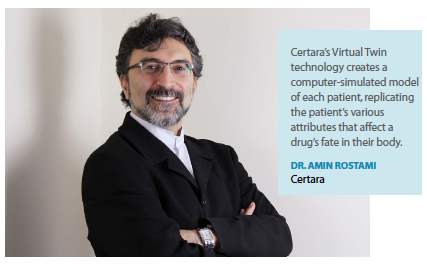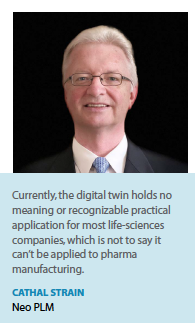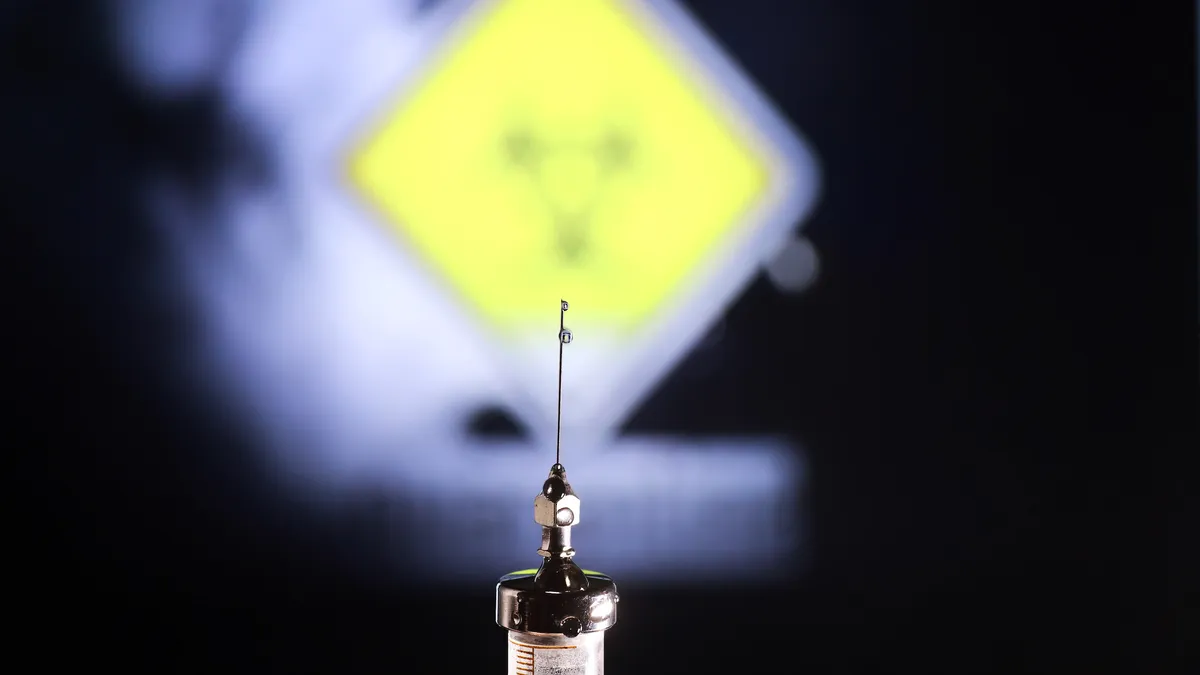While the digital twin is not yet widely used in the pharmaceutical industry, the concept has huge potential across R&D and manufacturing.
A decades-old technology is coming of age in the life-sciences industry, bringing with it the potential to solve many of the challenges companies continue to face. As companies continue to battle with pipeline shortages, a long and precarious drug development process, and manufacturing complexities, the industry has been looking to technologies such as the digital twin for answers.
The digital twin began life in the space industry in the 1960s with NASA using duplicated systems on the ground to replicate systems in space. It took several decades before the concept of the digital twin became more widely known and it wasn’t until the last few years that industries really began implementing the digital twin in operations.
 Today, digital twins are being used more widely as virtual representations of a production process, product, or service.
Today, digital twins are being used more widely as virtual representations of a production process, product, or service.
Key to enabling digital twins in the life sciences is the vast amount of data that can now be accessed via the cloud. But the challenge is to build digital twin teams with enough people or AI to digest all that research and apply it, says Gurpreet Singh, partner and health Services leader at PwC.
What is a Digital Twin?
Fundamentally, a digital twin is a model of an extremely complex system that makes it possible to simplify elements of those systems to make them practical, says Steve Levine, Ph.D., senior director of virtual human modeling systems, Dassault Systèmes.
In the context of the life sciences, there are digital twins of therapies and digital twins of the target patients, Mr. Singh says.
 “Therapy digital twins are increasingly getting better at representing the mechanism of action of a therapy," Mr. Singh says. “Digital twins of patients are growing in sophistication as more longitudinal biomarker data becomes available, and now the question becomes how to use that data to develop digital twins of real people."
“Therapy digital twins are increasingly getting better at representing the mechanism of action of a therapy," Mr. Singh says. “Digital twins of patients are growing in sophistication as more longitudinal biomarker data becomes available, and now the question becomes how to use that data to develop digital twins of real people."
Dr. Levine notes that digital twins can be made incredibly powerful to accurately predict many behaviors, but rarely will they predict all of them. However, unlike physical models the digital twins can become more accurate and patient-specific over time and can be adjusted to almost any scenario.
For example, Dassault’s Living Heart Project is used by hundreds of contributors, who publish their results and share them within a technical community so that a full understanding of the base model as well as any specific extensions can be made to address a given phenomenon.
In Certara’s case, its Virtual Twin is a modeling and simulation technology developed using the company’s Simcyp software platform.
The Virtual Twin technology creates a computer-simulated model of each patient, replicating the patient’s various attributes that affect a drug’s fate in his or her body.
“It is used to determine the optimal drug-dosing regimen for individual patients with the aim of maximizing a drug’s therapeutic effect while minimizing side effects," says Professor Amin Rostami, Pharm.D., Ph.D., senior VP of research and development and chief scientific officer at Certara. “It is a virtual or in silico technology."
Dr. Levine says digital twins can be configured to simulate the environment in which a medical product will be used, which means it can replace many of the bench and animal tests currently done.
“This not only saves money and time, but also allows researchers and manufacturers to optimize the product design, manufacturing, or even packaging, based on real-world conditions," he says.
Applying the Digital Twin in R&D
At the moment, only a small number of pharmaceutical companies are using digital twins in their operations, Dr. Levine says, however this number is growing. Examples range from patient or population-specific predictions of cardio toxicity for arrhythmias, anticoagulant and heart failure medications, novel drug delivery mechanisms for biologics, and precision electrical neuro-stimulation therapies.
“In pharmaceutical development, digital twins are typically limited to only the molecular or cellular level or simple 1D system models, not easily translatable to an organ or full body," he says, adding that the company’s 3D models can scale from the molecular to the human body and to populations such as those in a clinical trial. “Currently, few organizations are ready to fully capitalize on this technology, but companies are beginning to plan for this," Dr. Levine says.
Where the use of the digital twin is most advanced is in medical devices, such as the designs of new, minimally invasive heart valves that must collapse to be safely installed, expand for a secure fit in a dynamically changing environment, and must perform flawlessly to keep the patient alive, Dr. Levine says.
“Our digital twin of a human heart is being used widely for development and testing of these designs, and the FDA is currently evaluating it as a possible surrogate for patients in a clinical trial," he says.
The same technology is being used by FeOps, a start-up company within Dassault’s accelerator program, to predict the optimal device type, size, and location in a pre-surgical plan. And Digital Orthopedics is applying the same methodology to foot and ankle surgery.
Dr. Levine says an application currently under development is reconstruction of the spine and head of a patient suffering from a neuromuscular disease to optimize the formulation and delivery of a drug that is unable to pass through the blood-brain barrier.
“The goal is to predict the safe concentration throughout the brain and effective dosage to the targeted area," he says. “This will be used to develop the drug as well as become the protocol for safely administering the treatment. There is no alternative way to ensure the safety of these drugs."
The Patient and the Digital Twin
According to Mr. Singh, a digital twin can enable a more accurate prediction of the outcome of prescription drugs combined with lifestyle choices by running tests in silico using machine learning and scenario models combined with vast amounts of data to power the analysis. This would allow an understanding of the downstream health implications of choices patients make now and project the outcomes into the future.
“For example, will an extra hour of daily sleep reduce a patient’s potential to get diabetes?" Mr. Singh asks. “Will an exercise regimen combined with a prescription statin effectively reduce the potential for early organ failure?"
While it’s early days, Mr. Singh says digital twins are being used to determine potential side effects and potential outcomes across a larger population or cohort of patients.
“Recognizing that the great potential of a biologic is when it is used at precisely the right time in the progression of a patient’s disease-state lifecycle, pharma companies are building digital twin representatives of patient archetypes to better understand its application and timing options," he says.
Dr. Rostami says Certara’s Virtual Twin was born out of the revolution of model-informed drug development (MIDD), which is now being leveraged to some extent in more than 90% of all novel drug development.
“This revolution has enabled the industry to progress from providing a one-size-fits-all dosing approach to a paradigm of stratifying patients into bands with similar genetic, environmental, and physiological factors to provide more precise dosing guidance in the drug label," he says.
By way of example, Certara’s Simcyp Simulator was used to create virtual twins of prospective patients to predict olanzapine exposure, an antipsychotic drug.
The study began by validating the olanzapine physiologically based pharmacokinetics (PBPK) model against PK studies and data from therapeutic drug monitoring, Dr. Rostami explains.
Researchers then used the Simcyp Simulator healthy volunteer population file to create virtual twins of 14 patients. A single-dose clinical study was conducted in these patients, with the olanzapine systemic exposure accurately predicted by the virtual twins.
 “This means that mental health patients who may have very low exposure to olanzapine can be identified before starting treatment, and the dose increased to a suitable level or another drug is prescribed," he says. “This virtual twin approach is now being applied for other drugs with dosing problems all over the world, including anti-infectives, anti-coagulants, and anti-cancer medications."
“This means that mental health patients who may have very low exposure to olanzapine can be identified before starting treatment, and the dose increased to a suitable level or another drug is prescribed," he says. “This virtual twin approach is now being applied for other drugs with dosing problems all over the world, including anti-infectives, anti-coagulants, and anti-cancer medications."
Dr. Rostami says the Simcyp Simulator, which uses PBPK to provide the core technology behind Certara’s Virtual Twin, is used by most of the top 40 pharmaceutical companies for dose selection and labeling guidance.
PBPK enables drug developers to predict drug exposure levels based on patient and drug characteristics and concomitant medications.
“In fact, the technology has been used for the approval of more than 65 recent drugs, providing 200-plus label claims for dosing of stratified populations, including pediatrics, geriatrics, and patients with co-morbidities, without the need to conduct those clinical trials," he says.
However, Dr. Rostami says the Virtual Twin has not yet been adopted in clinical practice. To make that happen, three types of data are needed.
The first is data that influence PK, such as patient demographics, results of kidney and liver function tests, and any concurrent PK-interacting drugs. The second is data from patient blood tests that can provide key insights, for example, hematocrit and the drug-binding proteins albumin and alpha-1-acid glycoprotein (AAG), which are determinants of the fraction of unbound drug in blood. And the third is data that is only available during the drug development research phase, such as tissue biopsies.
“There are potential alternatives, such as validated biomarkers or plasma exosomes, which have begun to show promise," Dr. Rostami says.
“Certara has been investing in getting the information extracted and modeled with a view to rolling it into an enhanced virtual twin as we go forward."
Digital Twin Applications In Manufacturing
Cathal Strain, CEO of Neo PLM, says the digital twin aligns best with the discrete manufacturing world, noting that these concepts don’t easily translate to process industries such as the life sciences.
 However, there are scenarios in which it can be applied. The first is in research and development in terms of a digital definition of the manufacturing process. The second is in shop floor automation and execution systems to ensure the manufacturing process definition accurately reflects the requirements defined in the digital modeling stage. The third is in process analytics, where data could be exported from multiple sources, including execution and control systems, lab systems, and shop floor measurement devices.
However, there are scenarios in which it can be applied. The first is in research and development in terms of a digital definition of the manufacturing process. The second is in shop floor automation and execution systems to ensure the manufacturing process definition accurately reflects the requirements defined in the digital modeling stage. The third is in process analytics, where data could be exported from multiple sources, including execution and control systems, lab systems, and shop floor measurement devices.
“Contextualized data could then be transmitted to advanced analytics tools, enabling rich statistical analysis and latent variable modeling, as well as AI and machine learning capabilities," Mr. Strain says.
He says many life-sciences companies have deployed the digital twin for shop floor automation and process analytics, adding that some manufacturers have implemented shop floor control and manufacturing execution systems.
“The crucial missing component is the digital model or definition of the manufacturing process," Mr. Strain says. “Without this essential core, the digital twin effectively cannot function. Too many life-sciences companies still rely on spreadsheets and other documents to define key processes and product details at the start of the product lifecycle. As a result, many manufacturing plants continue to maintain paper-based shop floors. Because few facilities have deployed shop floor technologies, there is little real data substrate available to support process analytics."
Mr. Strain notes that to obtain richly contextualized production data ready for analysis, companies must begin building digital designs of their manufacturing processes to have functioning digital twins.(PV)
~~~~~~~~~~~~~~~~~~~~~~~~~
Replicating the Human Brain
As a leader in digital twin technology, Dassault Systèmes recognized the need from the neuroscience community to develop an efficient and flexible approach to address the macroscopic level of brain organization for simulating, reproducing, and probing the broad repertoire of brain activities and dynamics. The result is the Living Brain Project, which is being applied to traumatic brain injury, neuromodulation, neurodegenerative disease progression, and drug delivery through cerebrospinal fluid.
“The Living Brain Project has been set up in a slightly different structure from the Living Heart," says Steve Levine, Ph.D., senior director of virtual human modeling systems, Dassault Systèmes, referring to the company’s breakthrough 3D digital heart model. “Our understanding of the brain is less mature than the heart, and individual variability is greater, so we chose to begin with a number of small collaborations in domain specific areas. Some of these are public and others private."
All efforts involve reconstruction of a virtual twin of a patient’s brain, typically based on high-precision MRI, tomodensitometry, and electroencephalogram scans, Dr. Levine says. Depending on the application, physical, chemical, and electrical properties can be assigned to all regions as well as the white matter connectivity between regions, and even connectomes, which provide maps of the neural network.
“Once the virtual brain has been created, the virtual clinical treatments begin, in many instances in parallel with actual clinical investigations," he says. “Applications range from traumatic brain injury, neurodegenerative disease progression, and drug delivery as well as virtual surgeries such as craniotomies, aneurysms, epilepsy treatment, and neuromodulation."
Dr. Levine says by using the Living Brain to decompose behavioral response over time, it will become possible to develop a unique understanding of the physiological cause and, from there, develop an ideal treatment plan for a given patient.



















